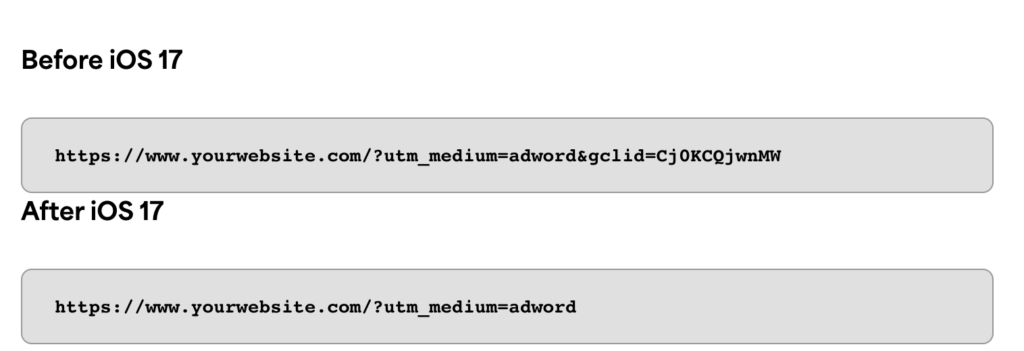How Will The iOS 17 Update Impact Your Marketing?
If you feel like you’re being bombarded with iOS 17 update information, you’re not alone. The recent Apple iOS update was announced back in June, and since then it has everyone talking, specifically marketers.
So, what’s going to change? Let’s take a look at the new features and how some of these changes are going to affect your marketing efforts.
What will the iOS 17 update feature?
There’s a lot to unpack in the new iOS update. Here’s a list of what’s been updated with new features and capabilities:
| Contact Posters | StandBy | Live voicemail |
| FaceTime | Widget Updates | Journal App |
| AirDrop | Accessibility | Private Browsing |
| Photos app | Messages | Apple Maps |
| Autocorrect Updates | Check In | Health app |
| Screen Distance | AirPlay | AirPods |
| AirTags | Notes app | Visual Look Up |
| Reminders app | Music App |
iOS 17 Update Brings Some Serious Challenges For Marketers – Link Tracking Protection
With all these updates come some serious challenges for marketers. One of the biggest changes with this update affects analytics and measurement: the removal of tracking parameters. This feature will be automatically activated with the new update across email, messages, and Safari. It detects user-identifiable tracking parameters within URLs and automatically removes them.

While this change could have various implications, the bottom line is that it will become slightly more difficult to pinpoint which links lead to conversions or determine the channels that contribute to sales. Even with these changes it won’t be entirely impossible to continue tracking this traffic.
Platforms affected by iOS 17 Tracking Parameter Removal
- HubSpot
- Twitter.com (X)
Potentially Affected in Future Updates:
- TikTok
- Mailchimp
- Klavyio
Tracking Parameters that will be removed
| __hsfp | gclid |
| __hssc | hsCtaTracking |
| __hstc | igshid |
| __s | mc_eid |
| _hsenc | mkt_tok |
| _openstat | ml_subscriber |
| dclid | ml_subscriber_hash |
| fbclid | msclkid |
| oly_anon_id | oly_enc_id |
| rb_clickid | vero_conv |
| yclid | wickedid |
| s_cid | vero_id |
| twclid |
Impact On Attribution
We already faced quite a few challenges regarding measurement and tracking from the last major privacy update. In the age of privacy and security concerns, it will likely be a continued challenge to anyone working with data.
This particular change to iOS users will make it even more difficult to track users through a multi-touch journey. This means the loss of Google and Meta click identifiers from ad clicks that we historically relied on, making the data collected less accurate. iOS users account for 30% of mobile browsing worldwide. So even if a small percentage is using private browsing it’s potentially a large audience. The use of targeting capabilities like remarketing and look-a-like audiences will also become more challenging.
The good news? It only impacts browsers using Safari in private mode. UTM’s will still be allowed, giving you traffic source data.
How To Minimize The Impact?
We can identify five ways to reduce the impact of these new restrictions on data collection connected to the iOS 17 update:
Focus on customer-first data
Customer-first data is the practice of collecting, managing, and using data in a way that prioritizes the interests and preferences of the user. It emphasizes putting the user’s needs, privacy, and trust at the forefront of data-related decisions and actions. This approach recognizes that consumers are becoming increasingly aware of how their data is used and are demanding more control and transparency.
Use clickID in a UTM
We may see channels incorporating the clickID into a UTM code. However, updating links across different sites will be time-consuming.
Try an arbitrary workaround
If channels decide to change the clickID name. For instance, instead of “fbclid,” attempt something like “brandname_fb” that would bypass iOS 17 link tracking protection. This is unlikely to happen but it would be a valid workaround.
Integrate clickID in the URL path
Integrating a clickID into a URL path typically involves appending the clickID to the URL as a parameter. You can adjust the code according to your specific programming language or framework. The key idea is to append the clickID as a query parameter to the URL path.
Segment iOS 17 traffic
Segment marketing to iOS 17 devices so all your other data is clean and accurate. This keeps your marketing attribution visibility for all non-iOS 17 devices unaffected.
Wrapping up – iOS 17 Link Tracking Protection
If we look back at historic changes in data collection, it isn’t all as bad as it initially seems. Privacy changes doesn’t mean we can’t continue to collect and report on accurate data. The amount of data available to marketers today is more than most know what to do with.
Marketers should be prepared for less transparency and understand what percentage of their target audience are Apple users, as this could directly correspond to changes in their data. Be prepared to put new processes in place to mitigate issues that may arise with these changes.